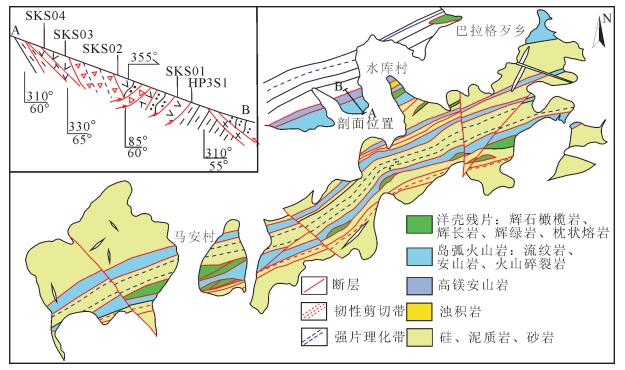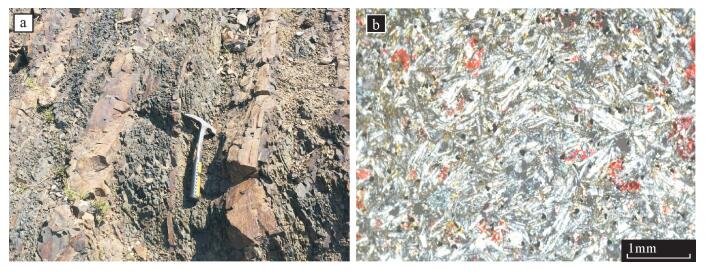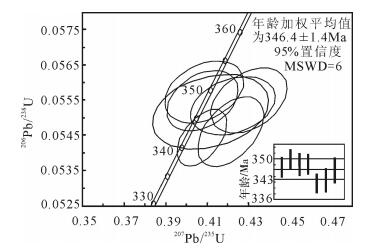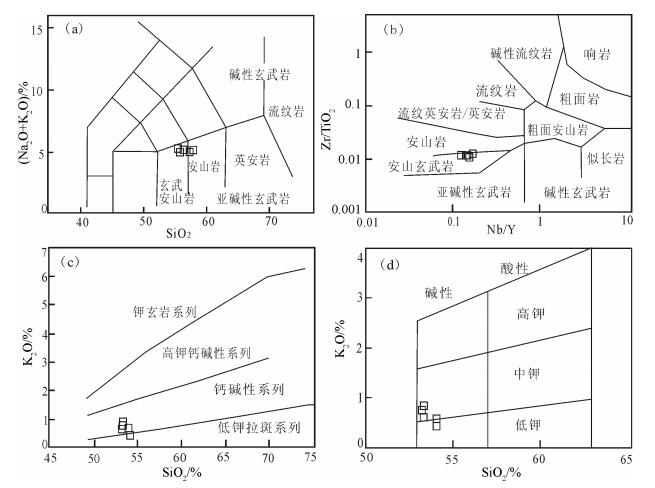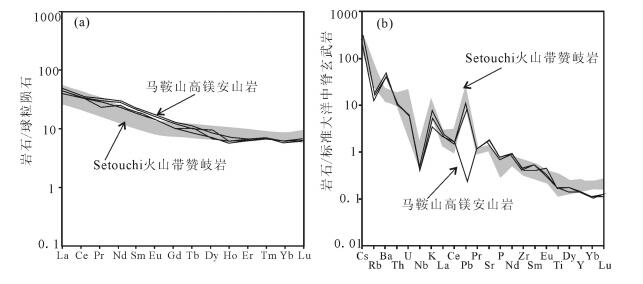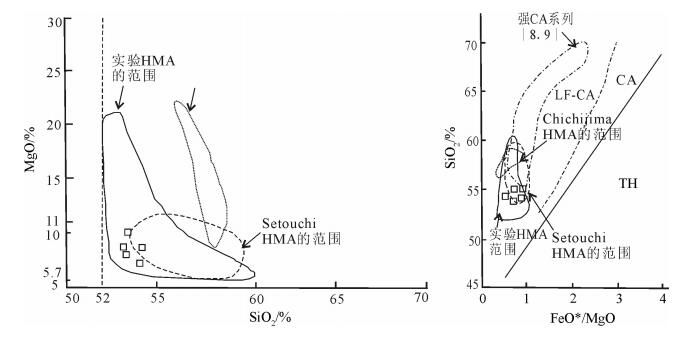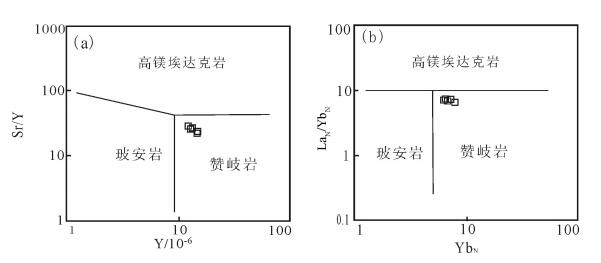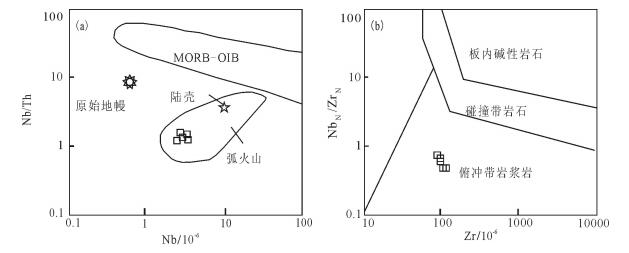Characteristics and geological significance of Early Carboniferous high-Mg andesites in Ma'anshan area, east Inner Mongolia
-
摘要:
内蒙古东部马鞍山地区发育早石炭世高镁安山岩,其LA-ICP-MS锆石U-Pb测年结果为346.4±1.4Ma,指示其形成于早石炭世。马鞍山高镁安山岩属于钙碱性岩石系列,SiO2含量为53.22%~54.22%,MgO为7.21%~10.03%,Al2O2为14.37%~15.94%,CaO为4.81%~5.94%,富Na、贫K(Na2O为3.87%~4.34%、K2O为0.49%~0.93%)、低TFeO/MgO(< 1.5)、高Cr(364×10-6~429×10-6)、Ni(204×10-6~211×10-6)。所有样品均显示轻稀土元素富集,具轻微的负Eu异常,富集大离子亲石元素Rb、K、Ba、Sr,亏损高场强元素Nb、Zr、Ti、Y、Yb、Lu等,地球化学特征与赞岐岩相似。由此可知,马鞍山地区早白垩世高镁安山岩是由地幔橄榄岩与消减洋壳板片部分熔融产生的富Si质熔体平衡反应的产物,暗示其形成于与俯冲消减有关的构造背景,是古亚洲洋闭合过程中洋陆转化的产物。
Abstract:The Early Carboniferous high-Mg andesites in Ma'anshan area of eastern Inner Mongolia have LA-ICP-MS zircon U-Pb age of 346.4±1.4Ma, indicating that they were formed in Early Carboniferous. Ma'anshan high-Mg andesites belong to calc-alkaline series, with SiO2 53.22%-54.22%, MgO 7.21%-10.03%, Al2O3 14.37%-15.94%, CaO 4.81%-5.94%, rich Na, poor K (Na2O 3.87%-4.34%, K2O 0.49%-0.93%), low TFeO/MgO(< 1.5), high Cr(364×10-6-429×10-6), and Ni (204×10-6-211×10-6). Similar to sanukite, all samples show enrichment of LREE and LILE (e.g., Rb, Ba, Sr and K), slight Eu negative anomaly and depletion of HFSE such as Nb, Zr, Ti, Y, Yb and Lu. They are equilibrium products of Sirich melt derived from partial melting of mantle peridotite and subducted oceanic crust, indicating a subduction background and suggesting that they were formed by ocean-continent transformation during the Palaeo-Asian Ocean closure.
-
Keywords:
- high-Mg andesites /
- sanukitie /
- zircon U-Pb age /
- geochemistry /
- Ma'anshan
-
高镁安山岩(high-Mg andesite,HMA)是指相比典型岛弧安山岩具有更高的MgO(>5%)和更低的TFeO/MgO值(<1.5)、Al2O3(<16%)和CaO(<10%)的安山岩,包括sanukitic HMA(sanukitie, 赞岐岩)、adakitic HMA(高镁埃达克岩)、bajaitic HMA(bajaitic,巴哈岩)和boninitic HMA(boninitic,玻安岩)4类,主要出露在日本岛弧Setouchi火山岩带和西阿留申群岛等地[1-4]。在地球演化历史中一般产于汇聚板块边缘[5],通常与年轻的或/和热的板片俯冲相联系,已成为汇聚板块边缘岩石圈地幔演化研究的一个重要指示器[6]。近些年的研究中,高镁安山岩被陆续报道,成为一个新的研究热点。
本文新识别的高镁安山岩从空间展布看位于二连-贺根山构造带向东延伸的部分。二连-贺根山构造带作为兴蒙造山带北部重要的构造单元,曾被认为是中朝板块和西伯利亚板块最后碰撞的缝合线位置[7],是研究古亚洲洋演化的重要线索之一。到目前为止,贺根山构造带的研究已经积累了大量资料,但对其构造属性仍然存在分歧,一些学者提出了俯冲环境(SSZ)的观点[5-7],Nozaka等[8]认为,贺根山蛇绿岩带为洋中脊型(MORB)。在其形成时代上,也存在不同的看法,泥盆纪、石炭纪、三叠纪均有报道[7-10]。
近年来针对内蒙古中部二连-贺根山缝合带内与古亚洲洋大洋俯冲有关的岛弧型岩浆岩的研究较多,但是,对该缝合带有关高镁安山岩的资料很少。仅在西乌旗梅劳特乌拉地区见有早二叠世岛弧型埃达克岩的报道[11]。本文通过马鞍山地区识别出的高镁安山岩LA-ICP-MS锆石U-Pb定年和岩石地球化学研究,结合区域地质资料,讨论马鞍山地区高镁安山岩的岩石成因及其形成的构造背景,为确定该地区早古生代亚洲洋的构造格局与演化历史提供重要的地质依据,为解决二连-贺根山构造缝合带的东延问题及约束其俯冲时限提供重要资料。
1. 地质概况及岩石学特征
研究区位于内蒙古东部,属于大兴安岭中南段,区域地质构造背景为中亚造山带东段华北陆块北缘增生带(图 1-a),兴安地块与松嫩地块的交接部位,二连浩特-贺根山缝合带的向东延伸的部分(图 1-b)。前中生代时期主要受西伯利亚板块与华北板块相互作用的影响,经历了古亚洲洋的消减、南北两大板块陆缘相向增生至最后拼接的演化历史。区内古生界发育地层有大石寨组(P1d^s)和林西组(P2l)。大石寨组为一套基性-中酸性熔岩及凝灰岩组合, 局部夹正常碎屑岩;林西组为一套黑色砂岩及板岩组合。
![]() 图 1 大兴安岭北段大地构造位置[12]Figure 1. Geotectonic position of the northern part of Da Hinggan Mountains
图 1 大兴安岭北段大地构造位置[12]Figure 1. Geotectonic position of the northern part of Da Hinggan Mountains笔者在开展中国地质调查局“内蒙古1:5万哈拉黑等八幅区调”项目时对马鞍山地区的大石寨组进行了详细的野外调查,以及较系统的岩石学、地球化学、年代学等研究,发现原大石寨组中断续分布的浊积岩、辉绿岩、枕状玄武岩、泥硅质岩、安山岩、英安岩、流纹岩、火山碎屑岩等,彼此之间呈断块接触。故将马鞍山地区原划分的大石寨组进行解体,拟重新将马鞍山地区大石寨组厘定为构造混杂岩。
本次工作所采集的安山岩样品即为马鞍山兴安水库“构造混杂岩”中的变质安山岩,采样位置见图 2。所采样品为变质安山岩,呈透镜状分布。围岩为泥质板岩和变质粉砂岩,具碎裂化局部糜棱岩化或强片理化。样品整体较新鲜,新鲜面呈灰黑色,斑状结构,斑晶含量小于10%,主要为斜长石;基质为玻晶交织结构,斜长石微晶具半定向排列,在斜长石间隙中充填角闪石微晶和玻璃质,角闪石均有不同程度的绿帘石化和碳酸盐化。
2. 锆石U-Pb测定结果
通过详细的野外工作和室内鉴定,选取弱蚀变的1个安山岩样品进行年龄测定。样品采自马鞍山兴安水库(HP3S1:北纬46°05′41″、东经121°36′11″)岩石宏观及镜下特征见图 3。对采集的安山岩样品进行锆石U-Pb同位素分析,锆石的分选在河北省区域地质矿产调查研究所实验室完成,采用重液浮选和电磁分离方法进行挑选。从约50kg的样品中选出了近120粒锆石,锆石的阴极发光(CL)显微照相在北京锆年领航科技有限公司完成。锆石原位U-Pb同位素年龄分析在中国地质科学院地球与物理研究所完成。激光剥蚀斑束直径为35μm,剥蚀深度为20~40μm。数据处理采用ICPMSDataCal 8.4程序,并采用Anderson方法对测试数据进行普通铅校正,年龄计算及谐和图绘制采用Isoplot (3.0版)完成。
分选出来的锆石均为透明无色,大多数为短柱状,只有少部分为长柱状、不规则状,一般长轴在80~120μm之间,长宽比在1~2之间。对分选出来的18颗锆石进行了分析,结果列于表 1。它们的Th含量为74.8×10-6~624.4×10-6,U含量为120×10-6~ 725×10-6,除11号点外,所有颗粒的Th/U值均大于0.4,为典型的岩浆锆石[13]。其中1、2、11号测点具有较老的207Pb/206Pb年龄,分别为2194±34Ma、2214± 18Ma、1809±21Ma,该类锆石在CL图像(图 4)上显示为次圆状或柱状,晶棱较模糊, 有的具有明显的增生边,可能为捕获锆石,代表来自古老结晶基底的岩石;另外3、4、8、12、19测点为统计离群点, 没有参加年龄计算, 6、17、20三个测点可能由于锆石本身有很多裂缝, 造成铅丢失, 使年龄偏小。其他测点在误差范围内具有谐和的年龄,获得的206Pb/238U年龄加权平均值为346.4±1.4Ma(图 5),可代表马鞍山地区高镁安山岩的喷发年龄。
表 1 马鞍山高镁安山岩(HP3S1)LA-ICP-MS锆石U-Th-Pb同位素分析结果Table 1. LA-ICP-MS zircon U-Th-Pb data of high-Mg andesite(HP3TW9-3)from Ma'anshan area测点 元素含量/10-6 Th/U 同位素比值 年龄/Ma 谐和度/% Pb Th U 207Pb*/206Pb* ± 1σ 207Pb*/235U ± 1σ 206Pb*/238U ± 1σ 206Pb/238U ± 1σ 207Pb/206Pb ± 1σ 1 71.91 99.93 146.43 0.68 0.1373 0.0023 7.5313 0.1225 0.3984 0.0031 2162 14 2194 34 99 2 152.9 148.73 316.62 0.47 0.1389 0.0015 7.9035 0.1077 0.4124 0.0039 2226 18 2214 18 99 3 8.94 79.09 120.07 0.66 0.0582 0.0019 0.5071 0.0157 0.0636 0.0007 398 4 539 70 95 4 12.04 128.60 161.56 0.80 0.0562 0.0018 0.4820 0.0159 0.0625 0.0007 391 4 457 70 97 5 19.33 171.73 304.96 0.56 0.0553 0.0017 0.4224 0.0135 0.0553 0.0005 347 3 433 73 97 6 12.87 298.43 424.52 0.70 0.0494 0.0017 0.1769 0.0063 0.0260 0.0003 165 2 165 86 99 7 22.07 347.71 312.01 1.11 0.0530 0.0015 0.4085 0.0125 0.0557 0.0006 350 4 328 63 99 8 17.40 127.72 212.38 0.60 0.0583 0.0019 0.5669 0.0198 0.0705 0.0008 439 5 543 74 96 9 19.28 237.39 285.84 0.83 0.0567 0.0017 0.4302 0.0121 0.0555 0.0006 348 4 480 65 95 10 21.46 271.99 318.28 0.85 0.0533 0.0014 0.4077 0.0114 0.0555 0.0006 348 3 343 94 99 11 85.10 78.82 241.55 0.33 0.1105 0.0013 4.8247 0.0702 0.3163 0.0032 1772 16 1809 21 99 12 53.45 588.49 725.05 0.81 0.0579 0.0013 0.4829 0.0112 0.0604 0.0005 378 3 524 50 94 13 39.39 283.38 656.10 0.43 0.0543 0.0010 0.4076 0.0078 0.0544 0.0005 342 3 383 45 98 14 10.99 94.71 153.83 0.62 0.0559 0.0022 0.4721 0.0173 0.0615 0.0007 385 4 450 119 97 15 10.24 261.63 334.77 0.78 0.0526 0.0020 0.1855 0.0072 0.0256 0.0003 163 2 309 87 94 16 31.25 255.46 515.54 0.50 0.0560 0.0013 0.4213 0.0105 0.0546 0.0007 343 4 454 18 95 18 11.64 141.38 173.09 0.82 0.0545 0.0025 0.4116 0.0185 0.0552 0.0007 346 4 391 108 98 19 44.30 272.45 523.40 0.52 0.0565 0.0010 0.5854 0.0109 0.0750 0.0007 466 4 472 44 99 20 14.31 624.41 539.38 1.16 0.0523 0.0017 0.1415 0.0041 0.0198 0.0002 126 2 298 69 93 注:表中测点编号前省略了“HP3” 3. 地球化学特征
主量、微量及稀土元素分析均在河北省区域地质矿产调查研究所地质实验室完成。主量元素分析采用Panalytical公司PW440型X荧光光谱仪(XRF)测定,分析误差低于5%,微量和稀土元素采用Thermo Fisher公司X-Seriesp型电感耦合等离子质谱仪(ICP-MS)测定,检测限优于5×10-9,相对标准偏差优于5%。具体分析结果列于表 2。
表 2 马鞍山地区高镁安山岩主量、微量与稀土元素化学成分Table 2. Chemical compositions of the high-Mg andesites from Ma'anshan area样品 HP3S1 SK01 SK02 SK03 SK04 SiO2 53.22 54.22 53.35 54.1 53.43 TiO2 0.75 0.75 0.76 0.74 0.75 Al2O3 15.94 15.27 15.25 15.27 14.37 Fe2O3 1.62 1.45 1.68 1.64 1.87 FeO 5 5.19 5.18 5.28 4.99 MnO 0.13 0.17 0.17 0.18 0.14 MgO 8.68 8.62 7.95 7.21 10.03 CaO 5.94 4.81 5.94 5.16 5.78 Na2O 4.34 4.33 4.27 4.12 3.87 K2O 0.81 0.49 0.68 0.66 0.93 P2O5 0.22 0.23 0.23 0.22 0.2 烧失量 3.17 2.67 3.19 2.88 3.46 总计 99.82 99.89 99.88 99.89 99.81 Mg# 0.72 0.72 0.7 0.68 0.74 Li 29.3 18.25 21.47 27.01 32.13 Be 0.91 0.91 0.91 0.77 0.81 Sc 21.6 21.33 26.92 28.93 25.75 V 145 169.7 164.8 154 162.2 Cr 369 364 365 370 428.8 Co 30.4 34.89 29.13 34.6 35.2 Ni 204 203.49 210.7 210.52 207.81 Ga 18.3 20.15 19.62 17.9 17.35 Rb 13.7 13.39 13.64 9.97 13.77 Sr 336 336.5 335 346.7 327.7 Nb 3.01 2.88 2.78 2.85 2.79 Cs 1.28 1.3 1.62 1.22 0.94 Ba 317 337.84 308.78 277.28 330.05 Hf 2.63 2.65 3.1 2.64 2.9 Ta 0.34 0.17 0.17 0.14 0.17 Pb 0.22 5 3.99 4.08 3.71 Th 2.08 1.99 1.9 1.85 1.86 U 0.54 0.44 0.5 0.42 0.48 Zr 89.4 91.12 92.78 83.37 104.5 Sr/Y 23.33 23.16 23.37 28.64 25.65 La 12.9 11.75 11.92 11.65 11.62 Ce 27.5 26.89 26.35 27.36 25.47 Pr 3.87 3.82 3.13 3.64 3.49 Nd 17.1 15.83 15.08 15.11 14.74 Sm 3.41 3.7 3.03 3.44 2.95 Eu 1.06 1.02 1.03 1.01 0.91 Gd 2.95 2.52 2.86 2.37 2.48 Tb 0.47 0.47 0.43 0.44 0.39 Dy 2.54 2.36 2.78 2.18 2.23 Ho 0.49 0.44 0.44 0.43 0.42 Er 1.37 1.44 1.33 1.35 1.19 Tm 0.21 0.23 0.21 0.22 0.21 Yb 1.28 1.27 1.27 1.28 1.26 Lu 0.21 0.2 0.21 0.2 0.19 Y 14.4 14.53 14.34 12.11 12.78 ΣREE 75.36 71.94 70.06 70.69 67.52 LREE/ HREE 6.92 7.05 6.36 7.34 7.08 LaN/YN 7.23 6.62 6.74 6.53 6.64 δEu 1 0.97 1.05 1.02 1 Ba/Th 152 169 162 149 177 Th/Yb 1.63 1.56 1.5 1.45 1.49 La/Sm 3.78 3.18 3.93 3.39 3.94 注:Mg#=100×Mg/(Mg+Fe2+);主量元素含量单位为%,微量和稀土元素单位为10-6 3.1 主量元素
安山岩样品SiO2含量在53.22%~54.22%之间;Al2O3含量为14.37%~15.94%;TiO2含量为0.74%~ 0.76%;MgO含量为7.21%~10.03%,Mg#=68~74;CaO含量为4.81%~5.94%;Na2O和K2O含量分别为3.87%~4.34%和0.49%~0.93%,样品均有Na2O>K2O的特征,显示富钠低钾;Na2O + K2O含量在4.98%~5.33%之间,在全碱- SiO2图解和Zr/TiO2- Nb/Y图解(图 6-a、b)中,所有样品均落入亚碱性火山岩系列,在SiO2-K2O图解中,样品均具有钙碱系列-低钾拉斑系列岩石特征,大部分样品显示偏低-低钾系列。
3.2 微量元素
安山岩的稀土元素总量(ΣREE)在68×10-6~ 75×10-6之间,球粒陨石标准化的REE配分图解显示稀土元素分布曲线右倾(图 7-a),轻稀土元素(LREE)富集,重稀土元素(HREE)亏损。(La/Yb)N= 7.38~7.53,轻、重稀土元素分异明显;没有明显的Eu负异常,δEu =0.97~1.05。在微量元素原始地幔标准化图解(图 7-b)上表现出大离子亲石元素(LILE)Cs、Sr、Rb、K、Ba明显富集,高场强元素Nb、Ta、P、Ti相对亏损。
4. 讨论
4.1 岩石成因
高镁安山岩(HMA)在现代地球上出露极少,但研究其成因对揭示地球的分异演化、地壳的生长、洋壳与洋脊或陆壳的俯冲、地壳拆沉及流体或熔体-地幔间的相互作用等具有非常重要的意义。因此,高镁安山岩的研究在近几十年受到广泛的关注。现阶段最主要的成果是将其按岩石地球化学特征划分为4类,并分别讨论了其岩石成因。其中,玻安岩(Boninite)通常出现在前弧环境,并以高SiO2(>52%)、MgO(>8%)和非常低TiO2含量(<0.5%)为特征,是消减带之上亏损的残留地幔含水熔蚀形成的。巴哈岩(Bajaite)是一种少见的岩石,具有非常高的Sr(>1000×10-6)、Ba含量(>1000×10-6)和高的K/Rb值(>1000),通常认为是地幔橄榄岩与来自消减板片部分熔蚀的富Si质熔体不平衡反应形成的[22-24]。埃达克岩具有高的SiO2(>56%)、Al2O(3>15%)、Sr(>400×10-6)和非常低的HREE(Yb<1.9×10-6)含量,是年轻的或热的消减板片或加厚下地壳的部分熔蚀形成的[25-26],而高镁埃达克岩(Mg#>50)可能与俯冲板片熔体形成的原始埃达克质岩浆在上升过程中与地幔楔的混合作用有关[27-28]。赞岐岩(Sanukite)通常出现于太古宙,其现代类似物为中新世产于日本Setouchi火山岩带的赞岐岩[29],具有LILE、LREE富集,HREE含量较低的特点,富含MgO、Ni和Cr[30]。
本区高镁安山岩与玻安岩相比TiO2(0.74%~0.76%)含量较高(表 3);与巴哈岩相比,其Sr(328×10-6~347×10-6)、Ba(177×10-6~330×10-6)含量较低,K/Rb值小于1000;与埃达克型高镁安山岩相比,其SiO2(53.22% ~54.22%)、Sr含量明显偏低,而HREE(Y为12.11×10-6~14.53×10-6)明显偏高,因而不属于这3类岩石。马鞍山高镁安山岩具富MgO(7.21% ~10.03%)、Cr(364×10-6~429×10-6)和Ni(203×10-6~211×10-6)、LILE、LREE富集、HREE含量低的特点。马鞍山高镁安山岩与赞岐岩具有相似的稀土和微量元素分布特征(图 7),且在SiO2- K2O图解(图 6)和SiO2-MgO、SiO2-TFeO/MgO图解(图 8)中,样品位于赞岐岩范围附近和实验的高镁安山岩HMA范围内。在微量元素确定的高镁安山岩分类图(图 9-b)上样品点均落入赞岐岩区,表明该高镁安山岩的形成可能与赞岐岩有相似的岩浆过程,属于赞岐岩型高镁安山岩。
表 3 典型高镁安山岩的主量、微量和稀土元素成分对比Table 3. Major elements, trace elements and REE data for several typical high-Mg andesites地区 Kamchatka
海峡墨西哥
Baja地区Setouchi
火山岩带日本
Bonin岛内蒙古
马鞍山地区岩石类型 埃达克型HMA 巴哈岩 赞岐岩 玻安岩 高镁安山岩 样品个数 5 9 47 31 5 SiO2 60.5~61.4 50.2~59.3 52.9~64.2 54.31~59.69 53.22~54.22 TiO2 0.90~0.98 0.65~3.47 0.39~1.25 0.07~0.29 0.74~0.76 Al2O3 15.7~16.2 13.6~18 14.1~18.5 8.02~14.44 14.37~15.94 TFeO 3.34~3.48 3.91~8.62 3.76~7.42 8.09~9.87 6.62~6.96 MnO 0.04~0.05 0.06~0.14 0.07~0.17 0.13~0.30 0.13~0.18 MgO 4.59~4.86 3.46~10.34 3.16~11.76 8.77~16.78 7.21~10.03 CaO 7.01~7.73 5.82~10.01 4.69~8.35 6.66~9.98 4.81~5.94 Na2O 3.59~3.76 2.83~5.35 2.20~4.11 0.76~2.27 3.87~4.34 K2O 2.12~2.43 0.71~4.24 0.92~2.60 0.24~0.72 0.49~0.93 P2O5 0.39~0.45 0.17~1.34 0.09~0.27 0.01~0.08 0.20~0.23 Na2O/K2O 1.63~1.77 1.8~5.5 1.09~2.75 1.43~4.83 4.18~8.92 Mg# 73~74 49~77 61~79 67~75 68~74 TFeO/MgO 0.71~0.76 0.60~1.83 0.56~1.15 0.58~0.91 0.68~0.96 Cr 161~184 43~490 332~752 600~1150 364~429 Ni 119~133 36~280 126~312 100~320 203~211 Rb 13~30 3.5~39 45~121 0.5~12 9.64~13.77 Sr 2302~2529 506~3800 245~331 61~97 328~347 Y - 5~23 11~18 2~5 12.11~14.53 Zr 63~470 - 68~119 11~25 83.37~104.48 Ba 280~2300 93~101 195~336 20~30 177~330 La 21.7~84 6.5~7.16 8.65~18.1 0.82~1.27 11.62~12.90 Yb 0.51~1.67 1.40~1.58 1.34~1.88 0.48~0.66 1.26~1.28 Sr/Y 45~506 20~21 15~28 12~29 23.16~28.64 La/Yb 15~48 4~5 5.14~10.13 1.43~2.15 9.10~10.07 注:HMA为高镁安山岩;Mg#=(100×Mg/(Mg+Fe2+)),氧化物为去水后标准化数据。数据来源:阿留申西部Kamchatka海峡的埃达克型高镁安山岩[3];墨西哥加利福尼亚Baja地区的巴哈岩[23];日本西南Setouchi火山岩带赞岐岩[18-20];日本Bonin岛玻安岩[21-24];主量元素含量单位为10%,微量和稀土元素为10-6 ![]() 图 8 马鞍山高镁安山岩的SiO2-MgO和SiO2-TFeO/MgO图解(底图据参考文献[31])Figure 8. Plots of SiO2-MgO and SiO2-TFeO/MgO for high-Mg andesites from Ma' anshan area
图 8 马鞍山高镁安山岩的SiO2-MgO和SiO2-TFeO/MgO图解(底图据参考文献[31])Figure 8. Plots of SiO2-MgO and SiO2-TFeO/MgO for high-Mg andesites from Ma' anshan area![]() 图 9 高镁安山岩分类图(底图据参考文献[32])Figure 9. The discrimination diagrams for high-Mg andesites
图 9 高镁安山岩分类图(底图据参考文献[32])Figure 9. The discrimination diagrams for high-Mg andesites马鞍山高镁安山岩富MgO (Mg#>0.60)、Cr和Ni, 表明其为地幔部分熔融形成[33];LILE、LREE富集,而HREE含量较低则暗示地幔源区要么受到消减带的影响, 要么地幔与来自板片的熔体发生了混合作用[34]。大部分学者认为,其源区是由地幔橄榄岩与消减洋壳板片或沉积物部分熔蚀的富Si质熔体平衡反应形成的[35],但可以确定的是,这2种假说都需要岩浆源区为交代地幔[36]。其具有明显的Nb、Ta亏损,相对富集LILE和LREE,Ba/La(23.8~ 28.76)和Ba/Th(149.6~177)值较大,而Th/Yb(1.45~1.63)值较小,暗示其源区物质成分受控于消减洋壳板片产生的熔体,并非沉积物部分熔融产生的熔体[36]。一般认为,如果岩浆在上升过程中受到地壳物质的混染,则La/Sm值会迅速增高,一般在5以上[37],而本区火山岩的La/Sm值(3.18~3.94)均低于5,可见没有明显的地壳物质混染。综上,马鞍山高镁安山岩的源区可能是由地幔橄榄岩与消减洋壳板片部分熔融产生的富Si质熔体平衡反应形成的,且岩浆在上升过程中未受到地壳物质的混染。
4.2 构造背景
古亚洲洋在东北地区最终闭合的时间与地点是古亚洲构造域演化的重要问题,也是长期争论的焦点。主要观点有:古亚洲洋最后消失在西拉沐伦河—长春—延吉一线[38-40],关于闭合时间,部分学者主张在二叠纪末[41-42],还有部分学者主张在晚志留世—晚泥盆世[43-46]。古亚洲洋最后消失在贺根山—嫩江—黑河一线[47-48],其闭合时间,一部分学者认为是晚古生代[49],另一部分学者认为是印支期[50-51]。
本文研究的马鞍山高镁安山岩位于二连浩特-贺根山缝合带向东延伸的部分。该高镁安山岩的形成可能与赞岐岩有相似的岩浆过程,目前认为赞岐岩的形成通常与年轻的或/和热的板片俯冲相联系[52-53]。通常陆缘弧火山岩浆为高钾和钾玄系列岩浆,较大洋弧高K、Sr、Rb、Ba、Zr、Th和U[54-55]。研究区安山岩ΣREE为68×10-6~75×10-6,且均为钠质低钾钙碱性-岛弧拉斑系列火山岩(Na2O/K2O= 1.18~8.92) (图 5-c、d),火山岩地球化学特征更接近大洋岛弧特征。在Nb/Th-Nb图解(图 10-a)中样品点全部落入弧火山岩范围内,在Zr-NbN/ZrN构造环境判别图(图 10-b)上,样品落入俯冲带岩浆区,说明其形成环境与板块俯冲有关。笔者在开展内蒙古1:5万哈拉黑等八幅区调过程中,在马鞍山地区获得辉绿岩U-Pb年龄344.4±1.4Ma与马鞍山高镁安山岩U-Pb年龄364.4±1.4Ma相互印证。表明该时期在内蒙古马鞍山地区古亚洲洋没有闭合,可能仍有俯冲作用,进一步证实本区处于消减构造背景。
![]() 图 10 Nb-Nb/Th和Zr-NbN/ZrN构造环境判别图(底图据参考文献[56])Figure 10. Nb-Nb/Th and Zr-NbN/ZrN discrimination diagrams for tectonic setting
图 10 Nb-Nb/Th和Zr-NbN/ZrN构造环境判别图(底图据参考文献[56])Figure 10. Nb-Nb/Th and Zr-NbN/ZrN discrimination diagrams for tectonic setting5. 结论
(1)马鞍山高镁安山岩(SiO2=53.22%)具有高MgO(8.68%),高Mg#值(0.68~0.74),高Cr(364×10-6)、Ni(204×10-6),低TFeO/MgO(<1.5)、Al2O3(<16%)和CaO(<10%)等特征。富集大离子亲石元素(如Rb、K、Ba、Sr),亏损高场强元素(Nb、Zr、Ti、Y、Yb、Lu等),富集轻稀土元素,亏损重稀土元素,地球化学特征与赞岐岩相似,是由地幔橄榄岩与消减洋壳板片部分熔融产生的富Si质熔体平衡反应的产物,暗示其形成于与俯冲消减有关的构造背景。
(2)在内蒙古东部二连-贺根山缝合带及周边区域关于高镁安山岩的报道本文可能尚属首次。马鞍山高镁安山岩的LA-ICP-MS锆石U-Pb年龄为346.4±1.4Ma,提供了二连-贺根山缝合带在马鞍山地区存在早石炭世高镁安山岩的年代学证据与约束,表明早石炭世古亚洲洋可能存在大洋俯冲作用,为二连-贺根山缝合带的俯冲时限提供了新的证据。
(3)马鞍山高镁安山岩形成于消减带的构造背景可以与本区兴安水库构造混杂岩及化石山蛇纹石化橄榄岩相互印证,表明本区确实存在板块消减带(缝合带),为二连-贺根山缝合带在东部的延伸提供了资料。
致谢: 中国地质调查局沈阳地质调查中心汪岩教授级高工、钱程高级工程师详细审阅全文并提出了宝贵的建议,同时审稿专家也提出的宝贵建议,在此表示衷心的感谢。 -
图 1 大兴安岭北段大地构造位置[12]
Figure 1. Geotectonic position of the northern part of Da Hinggan Mountains
图 8 马鞍山高镁安山岩的SiO2-MgO和SiO2-TFeO/MgO图解(底图据参考文献[31])
Figure 8. Plots of SiO2-MgO and SiO2-TFeO/MgO for high-Mg andesites from Ma' anshan area
图 9 高镁安山岩分类图(底图据参考文献[32])
Figure 9. The discrimination diagrams for high-Mg andesites
图 10 Nb-Nb/Th和Zr-NbN/ZrN构造环境判别图(底图据参考文献[56])
Figure 10. Nb-Nb/Th and Zr-NbN/ZrN discrimination diagrams for tectonic setting
表 1 马鞍山高镁安山岩(HP3S1)LA-ICP-MS锆石U-Th-Pb同位素分析结果
Table 1 LA-ICP-MS zircon U-Th-Pb data of high-Mg andesite(HP3TW9-3)from Ma'anshan area
测点 元素含量/10-6 Th/U 同位素比值 年龄/Ma 谐和度/% Pb Th U 207Pb*/206Pb* ± 1σ 207Pb*/235U ± 1σ 206Pb*/238U ± 1σ 206Pb/238U ± 1σ 207Pb/206Pb ± 1σ 1 71.91 99.93 146.43 0.68 0.1373 0.0023 7.5313 0.1225 0.3984 0.0031 2162 14 2194 34 99 2 152.9 148.73 316.62 0.47 0.1389 0.0015 7.9035 0.1077 0.4124 0.0039 2226 18 2214 18 99 3 8.94 79.09 120.07 0.66 0.0582 0.0019 0.5071 0.0157 0.0636 0.0007 398 4 539 70 95 4 12.04 128.60 161.56 0.80 0.0562 0.0018 0.4820 0.0159 0.0625 0.0007 391 4 457 70 97 5 19.33 171.73 304.96 0.56 0.0553 0.0017 0.4224 0.0135 0.0553 0.0005 347 3 433 73 97 6 12.87 298.43 424.52 0.70 0.0494 0.0017 0.1769 0.0063 0.0260 0.0003 165 2 165 86 99 7 22.07 347.71 312.01 1.11 0.0530 0.0015 0.4085 0.0125 0.0557 0.0006 350 4 328 63 99 8 17.40 127.72 212.38 0.60 0.0583 0.0019 0.5669 0.0198 0.0705 0.0008 439 5 543 74 96 9 19.28 237.39 285.84 0.83 0.0567 0.0017 0.4302 0.0121 0.0555 0.0006 348 4 480 65 95 10 21.46 271.99 318.28 0.85 0.0533 0.0014 0.4077 0.0114 0.0555 0.0006 348 3 343 94 99 11 85.10 78.82 241.55 0.33 0.1105 0.0013 4.8247 0.0702 0.3163 0.0032 1772 16 1809 21 99 12 53.45 588.49 725.05 0.81 0.0579 0.0013 0.4829 0.0112 0.0604 0.0005 378 3 524 50 94 13 39.39 283.38 656.10 0.43 0.0543 0.0010 0.4076 0.0078 0.0544 0.0005 342 3 383 45 98 14 10.99 94.71 153.83 0.62 0.0559 0.0022 0.4721 0.0173 0.0615 0.0007 385 4 450 119 97 15 10.24 261.63 334.77 0.78 0.0526 0.0020 0.1855 0.0072 0.0256 0.0003 163 2 309 87 94 16 31.25 255.46 515.54 0.50 0.0560 0.0013 0.4213 0.0105 0.0546 0.0007 343 4 454 18 95 18 11.64 141.38 173.09 0.82 0.0545 0.0025 0.4116 0.0185 0.0552 0.0007 346 4 391 108 98 19 44.30 272.45 523.40 0.52 0.0565 0.0010 0.5854 0.0109 0.0750 0.0007 466 4 472 44 99 20 14.31 624.41 539.38 1.16 0.0523 0.0017 0.1415 0.0041 0.0198 0.0002 126 2 298 69 93 注:表中测点编号前省略了“HP3” 表 2 马鞍山地区高镁安山岩主量、微量与稀土元素化学成分
Table 2 Chemical compositions of the high-Mg andesites from Ma'anshan area
样品 HP3S1 SK01 SK02 SK03 SK04 SiO2 53.22 54.22 53.35 54.1 53.43 TiO2 0.75 0.75 0.76 0.74 0.75 Al2O3 15.94 15.27 15.25 15.27 14.37 Fe2O3 1.62 1.45 1.68 1.64 1.87 FeO 5 5.19 5.18 5.28 4.99 MnO 0.13 0.17 0.17 0.18 0.14 MgO 8.68 8.62 7.95 7.21 10.03 CaO 5.94 4.81 5.94 5.16 5.78 Na2O 4.34 4.33 4.27 4.12 3.87 K2O 0.81 0.49 0.68 0.66 0.93 P2O5 0.22 0.23 0.23 0.22 0.2 烧失量 3.17 2.67 3.19 2.88 3.46 总计 99.82 99.89 99.88 99.89 99.81 Mg# 0.72 0.72 0.7 0.68 0.74 Li 29.3 18.25 21.47 27.01 32.13 Be 0.91 0.91 0.91 0.77 0.81 Sc 21.6 21.33 26.92 28.93 25.75 V 145 169.7 164.8 154 162.2 Cr 369 364 365 370 428.8 Co 30.4 34.89 29.13 34.6 35.2 Ni 204 203.49 210.7 210.52 207.81 Ga 18.3 20.15 19.62 17.9 17.35 Rb 13.7 13.39 13.64 9.97 13.77 Sr 336 336.5 335 346.7 327.7 Nb 3.01 2.88 2.78 2.85 2.79 Cs 1.28 1.3 1.62 1.22 0.94 Ba 317 337.84 308.78 277.28 330.05 Hf 2.63 2.65 3.1 2.64 2.9 Ta 0.34 0.17 0.17 0.14 0.17 Pb 0.22 5 3.99 4.08 3.71 Th 2.08 1.99 1.9 1.85 1.86 U 0.54 0.44 0.5 0.42 0.48 Zr 89.4 91.12 92.78 83.37 104.5 Sr/Y 23.33 23.16 23.37 28.64 25.65 La 12.9 11.75 11.92 11.65 11.62 Ce 27.5 26.89 26.35 27.36 25.47 Pr 3.87 3.82 3.13 3.64 3.49 Nd 17.1 15.83 15.08 15.11 14.74 Sm 3.41 3.7 3.03 3.44 2.95 Eu 1.06 1.02 1.03 1.01 0.91 Gd 2.95 2.52 2.86 2.37 2.48 Tb 0.47 0.47 0.43 0.44 0.39 Dy 2.54 2.36 2.78 2.18 2.23 Ho 0.49 0.44 0.44 0.43 0.42 Er 1.37 1.44 1.33 1.35 1.19 Tm 0.21 0.23 0.21 0.22 0.21 Yb 1.28 1.27 1.27 1.28 1.26 Lu 0.21 0.2 0.21 0.2 0.19 Y 14.4 14.53 14.34 12.11 12.78 ΣREE 75.36 71.94 70.06 70.69 67.52 LREE/ HREE 6.92 7.05 6.36 7.34 7.08 LaN/YN 7.23 6.62 6.74 6.53 6.64 δEu 1 0.97 1.05 1.02 1 Ba/Th 152 169 162 149 177 Th/Yb 1.63 1.56 1.5 1.45 1.49 La/Sm 3.78 3.18 3.93 3.39 3.94 注:Mg#=100×Mg/(Mg+Fe2+);主量元素含量单位为%,微量和稀土元素单位为10-6 表 3 典型高镁安山岩的主量、微量和稀土元素成分对比
Table 3 Major elements, trace elements and REE data for several typical high-Mg andesites
地区 Kamchatka
海峡墨西哥
Baja地区Setouchi
火山岩带日本
Bonin岛内蒙古
马鞍山地区岩石类型 埃达克型HMA 巴哈岩 赞岐岩 玻安岩 高镁安山岩 样品个数 5 9 47 31 5 SiO2 60.5~61.4 50.2~59.3 52.9~64.2 54.31~59.69 53.22~54.22 TiO2 0.90~0.98 0.65~3.47 0.39~1.25 0.07~0.29 0.74~0.76 Al2O3 15.7~16.2 13.6~18 14.1~18.5 8.02~14.44 14.37~15.94 TFeO 3.34~3.48 3.91~8.62 3.76~7.42 8.09~9.87 6.62~6.96 MnO 0.04~0.05 0.06~0.14 0.07~0.17 0.13~0.30 0.13~0.18 MgO 4.59~4.86 3.46~10.34 3.16~11.76 8.77~16.78 7.21~10.03 CaO 7.01~7.73 5.82~10.01 4.69~8.35 6.66~9.98 4.81~5.94 Na2O 3.59~3.76 2.83~5.35 2.20~4.11 0.76~2.27 3.87~4.34 K2O 2.12~2.43 0.71~4.24 0.92~2.60 0.24~0.72 0.49~0.93 P2O5 0.39~0.45 0.17~1.34 0.09~0.27 0.01~0.08 0.20~0.23 Na2O/K2O 1.63~1.77 1.8~5.5 1.09~2.75 1.43~4.83 4.18~8.92 Mg# 73~74 49~77 61~79 67~75 68~74 TFeO/MgO 0.71~0.76 0.60~1.83 0.56~1.15 0.58~0.91 0.68~0.96 Cr 161~184 43~490 332~752 600~1150 364~429 Ni 119~133 36~280 126~312 100~320 203~211 Rb 13~30 3.5~39 45~121 0.5~12 9.64~13.77 Sr 2302~2529 506~3800 245~331 61~97 328~347 Y - 5~23 11~18 2~5 12.11~14.53 Zr 63~470 - 68~119 11~25 83.37~104.48 Ba 280~2300 93~101 195~336 20~30 177~330 La 21.7~84 6.5~7.16 8.65~18.1 0.82~1.27 11.62~12.90 Yb 0.51~1.67 1.40~1.58 1.34~1.88 0.48~0.66 1.26~1.28 Sr/Y 45~506 20~21 15~28 12~29 23.16~28.64 La/Yb 15~48 4~5 5.14~10.13 1.43~2.15 9.10~10.07 注:HMA为高镁安山岩;Mg#=(100×Mg/(Mg+Fe2+)),氧化物为去水后标准化数据。数据来源:阿留申西部Kamchatka海峡的埃达克型高镁安山岩[3];墨西哥加利福尼亚Baja地区的巴哈岩[23];日本西南Setouchi火山岩带赞岐岩[18-20];日本Bonin岛玻安岩[21-24];主量元素含量单位为10%,微量和稀土元素为10-6 -
唐功建, 王强.高镁安山岩及其动力学意义[J].岩石学报, 2010, 26(8):495-512. http://d.old.wanfangdata.com.cn/Periodical/ysxb98201008021 曹从周, 田昌烈, 杨芳林.内蒙古索伦山-贺根山蛇绿岩带中席状岩墙群及其地质意义[C]//地质矿产部沈阳地质矿产研究所编.中国北方板块构造论文集(2).北京: 地质出版社, 1987: 125-135. Yogodzinski G M, Kay R W, Volynets O N, et al. Magnesian andesite in the western Aleutian Komandorsky Region:Implications for slab melting and processes in the mantle wedge[J]. Geological Society of America Bulletin, 1995, 107(5):505-519. doi: 10.1130/0016-7606(1995)107<0505:MAITWA>2.3.CO;2
Tatsumi Y. Origin of high-magnesian andesites in the Setouchi volcanic belt, southwest Japan, Ⅱ. Melting phase relations at high pressures[J]. Earth and Planetary Science Letters, 1982, 60(2):305-317. doi: 10.1016/0012-821X(82)90009-7
Li J Y. Permian geodynamic setting of Northeast China and adjacen-tregions:Closure of the Paleo-Asian Ocean and subduction of the Paleo-Pacific Plate[J]. Journal of Asian Earth Sciences, 2006, 26(3/4):207-224. http://en.cnki.com.cn/Article_en/CJFDTOTAL-SYYT200605022.htm
Robinson P T, Zhou M F, Hu X F, et al. Geochemical constraints on the origin of the Hegenshan ophiolite, Inner Mongolia, China[J]. Journal of Asian Earth Sciences, 1999, 17(4):423-442. doi: 10.1016/S1367-9120(99)00016-4
Miao L C, Fan W M, Liu D Y, et al. Geochronology and geochemistry of the Hegenshanophioliticcomplex:Implications for late-stage tectonic evolution of the Inner Mongolia-Daxinganling Orogenic Belt, China[J]. Journal of Asian EarthSciences, 2008, 32(5/6):348-370. http://www.sciencedirect.com/science/article/pii/S1367912007002222
Nozaka T, Liu Y. Petrology of the Hegenshan ophiolite and its implication for the tectonic evolution of northern China[J]. Earth and Planetary Science Letters, 2002, 202:89-104. doi: 10.1016/S0012-821X(02)00774-4
黄波, 付东, 李树才等.内蒙古贺根山蛇绿岩形成时代及构造启示[J].岩石学报, 2016, 3(1):158-176. http://d.old.wanfangdata.com.cn/Periodical/ysxb98201601020 Jian P, Koroener A, Windley B F, et al. Carboniferous and Cretaceous mafic-ultramafic massifs in Inner Mongolia(China):A SHRIMP zircon and geochemical study of the previously presumed integral "Hegenshan ophiolite"[J]. Lithos, 2012, 142:48-66. http://www.sciencedirect.com/science/article/pii/S0024493712000990
王金芳, 李英杰, 李红阳, 等.内蒙古梅劳特乌拉蛇绿岩中埃达克岩的发现及其演化模式[J].地质学报, 2017, 91(8):1776-1795. doi: 10.3969/j.issn.0001-5717.2017.08.009 赵春荆, 彭玉鲸, 党增欣, 等.吉黑东部构造格架及地壳演化[M].沈阳:辽宁大学出版社, 1996:1-186. 吴元宝, 郑永飞.锆石成因矿物学研究及对U-Pb年龄解释的制约[J].科学通报, 2004, 49(16):1589-1604. doi: 10.3321/j.issn:0023-074X.2004.16.002 Le Maitre R W, Bateman P, Dudek A, et al. A Classification of Igneous Rocks and Glossary of Terms:Recommendations of the International Union of Geological Sciences Subcommission on the Systematics of igneous rocks[M]. Oxford:Blackwell, 1989:1-193.
Winchester J A, Floyd P A. Geochemical discrimination of different magma series and their differentiation products using immobile elements[J]. Chemical Geology, 1977, 20:325-343. doi: 10.1016/0009-2541(77)90057-2
Peccerillor R, Taylor S R. Geochemistry of eocene calc-alkaline volcanic rocks from the Kastamonu area, northern Turkey[J]. Contributions to Mineralogy and Petrology, 1976, 58(1):63-81. doi: 10.1007/BF00384745
Gill J B. Bulk chemical composition of orogenic andesites[C]//Orogenic Andesites and Plate Tectonics. Berlin, Heidelberg: Springer, 1981: 97-167.
Tatsumi Y, Ishizaka K. Existence of andesitic primary magma:An example from southwest Japan[J]. Earth and Planetary Science Letters, 1981, 53(1):124-130. doi: 10.1016/0012-821X(81)90033-9
Tatsumi Y, Hanyu T.Geochemical modeling of dehydration and partial melting of subducting lithosphere:Toward a comprehen-siveunderstanding of high-Mg andesite formation in the Setouchi volcanic belt, SW Japan[J]. Geochemistry Geophysics Geosystems, 2003, 4(9):1081, doi: 10.1029/2003GC000530.
Tatsumi Y.High-Mg andesites in the Setouchi volcanic belt, southwestern Japan:Analogy to Archean magmatism and continental[J]. Earth and Planetary Science Letters, 2006, 52(1):104-125.
Sun S S, McDonough W F. Chemical and isotopic systematics ofoceanic basalts: Implications for mantle composition and processed[C]//Saunders A D, Norry M J. Magmatism in the OceanBasins. Geological Society, London, Special Publications, 1989, 42(1): 313-345.
邓晋福, 冯艳芳.高镁安山岩/闪长岩类(HMA)和镁安山岩/闪长岩类(MA):与洋俯冲作用相关的两类典型的火成岩类[J].中国地质, 2010, 37(4):1112-1118. doi: 10.3969/j.issn.1000-3657.2010.04.025 Rogers G, Saunders A D, Terrell D J, et al. Geochemistry of Holocene volcanic rocks associated with ridge subduction in Baja California Mexico[J]. Nature, 1985, 315(6018):389-392. doi: 10.1038/315389a0
Umino S.Magma mixing in boninite sequence of Chichijima Bonin Islands[J]. Journal of Volcanology and Geothermal Research, 1986, 29(1/4):125-157 doi: 10.1016-0377-0273(86)90042-9/
Saunders A D, Rogers G, Marriner G F, et al. Geochemistry of Cenezoic volcanic rocks, Baja California, Mexico:Implications for the petrogenesis of post-subduction magmas[J]. Journalof Volcanology and Geothermal Research, 1987, 32(1/3):223-245. doi: 10.1016-0377-0273(87)90046-1/
Defant M J, Drummond M S. Derivation of some modern arc magmas by melting of young subducted lithosphere[J].Nature, 1990, 347(6294):662-665. doi: 10.1038/347662a0
Atherton M P, Petford N. Generantion of sodium-rich magmas from newly underplanted basaltic crust[J]. Nature, 1993, 362:144-146. doi: 10.1038/362144a0
Shirey S B, Hanson G N. Mantle-derived Archean monzodiorites and trachyandesites[J]. Nature, 1984, 310(10):222-224.
Smithies R H. The Archaean tonalite-trondhjemite-granodiorite (TTG) series is not an analogue of Cenozoic adakite[J].Earth and Planetary Science Letters, 2000, 182(1):115-125. doi: 10.1016/S0012-821X(00)00236-3
张旗, 钱青, 翟明国, 等. Sanukite(赞岐岩)的地球化学特征、成因及地球动力学意义[J].岩石矿物学杂志, 2005, 24(2):117-125. doi: 10.3969/j.issn.1000-6524.2005.02.005 Stern R A, Hanson G N, Shirey S B. Petrogenesis of mantlederived, LILE-enriched Archean monzodiorites and trachyandesites(sanukitoids) in southwestern Superior Province[J]. Canadian Journalof Earth Sciences, 1989, 26:1688-1712. doi: 10.1139/e89-145
Kanei A, Owada M, Nagao T, et al. High-Mg diorites derived from sanukitic HMA magmas, Kyushu Island, southwest Japan arc:Evidence from clinopyroxene and whole rock compositions[J]. Lithos, 2004, 75.359-371. doi: 10.1016/j.lithos.2004.03.006
Rollison H R. Using Geochemical Data; Evaluation[J]. Presentation, Interpretation[M]. LongmanGrup, UK Ltd, 1993: 1-275.
Smithies R H, Champion D C. The Archaean high-Mg diorite suite:Links to tonalite-trondhjemite-granodiorite mdumatism and implications for Early Archaean crustal growth[J]. Journal of Petrology, 2000:1653-1671. http://www.tandfonline.com/servlet/linkout?suffix=CIT0091&dbid=16&doi=10.1080%2F00206814.2017.1377121&key=10.1093%2Fpetrology%2F41.12.1653
Smithies R H, Champion D C. Adakite, TTG and Archaean crustal evolution.European Geophysical Society[J].Geophysical Research Abstracts, 2003:1630. http://adsabs.harvard.edu/abs/2003eaeja.....1630s
Shimoda G, Tatsumi Y, Nohda S, et al. Setouchi high-Mg andesites revisited:Geochemical evidence for melting of subducted sediments[J]. Earth and Planetary Science Letters, 1998, 160:479-492. doi: 10.1016/S0012-821X(98)00105-8
Yin J Y, Yuan C, Sun M, et al. Late Carboniferous high-Mg dioritic dikes in westem Junggar NWChina:Geochemical features, petrogenesis and tectonic implications[J]. Gondwana Research, 2010, 17:145-152. doi: 10.1016/j.gr.2009.05.011
Lassiter J C, DePaolo D J. Plume lithosphere interaction in the generation of continental and oceanic flood basalts chemical and isotopic constraints[C]//Mahoney J, Coffin F(eds.), . 1997, Large 145-152.
王玉净, 樊志勇.内蒙古西拉木伦河北部蛇绿岩带中二叠纪放射虫的发现及其地质意义[J].古生物学报, 1997, 36(1):58-69. http://www.cnki.com.cn/Article/CJFDTOTAL-GSWX701.004.htm 孙德有, 吴福元, 张艳斌, 等.西拉木伦河-长春-延吉板块缝合带的最后闭合时间-来自吉林大玉山花岗岩体的证据[J].吉林大学学报(地球科学版), 2004, 34(2):174-181. http://d.old.wanfangdata.com.cn/Periodical/cckjdxxb200402003 Zhou X H, Ying J F, Zhang L C, et al. The petrogenesis of Late Mesozoic volcanic rock and the contributions from ancient Microcontinents:Constraints from the zircon U-Pb dating and Sr-Nd-Pb-Hfisotopic systematics[J]. Earth Science, 2009, 34(1):Ⅰ-10(in Chinesewith English abstract).
李春昱.中同板块构造的轮廓[J].中国地质科学院院报, 1980, 2(1):11-22. http://kns.cnki.net/KCMS/detail/detail.aspx?filename=DZKT198108004&dbname=CJFD&dbcode=CJFQ 王鸿祯.中国地壳构造发展主要阶段[J].地球科学, 1982, 7(3):155-177. http://kns.cnki.net/KCMS/detail/detail.aspx?filename=DQKX198203015&dbname=CJFD&dbcode=CJFQ 何国琦, 邵济安.内蒙古东南部(昭盟)西拉木伦河一带早古生代蛇绿岩建造的确定及其大地构造意义[C]//中同北方板块构造文集.武汉: 中国地质大学出版社, 1983: 243-250. 李锦轶.内蒙古东部中朝板块与西伯利亚板块之间古缝合带初步研究[J].科学通报, 1986, 31(14):1093-1096. http://kns.cnki.net/KCMS/detail/detail.aspx?filename=KXTB198614014&dbname=CJFD&dbcode=CJFQ 唐克东.中朝陆台北侧裙皱代构造发展的几个问题[J].现代地质, 1989, 3(2):195-204. 唐克东.颜竹窍, 张允平, 等.内蒙古缝合带的地质特征与构造演化[J].中国地质科学院沈阳地质矿产所集刊, 1995, 5/6:119-166. http://cdmd.cnki.com.cn/Article/CDMD-10183-1016079192.htm Tang K D.Tectonic development of Paleozoic fold belts at the north margin of the Sino-Korean craton[J].Tectonics, 1990, 9:249-260. doi: 10.1029/TC009i002p00249
邵济安, 牟保磊, 何国琦, 等.华北北部在古亚洲洋域与太平洋域构造叠加过程中的地质作用[J].中国科学(D辑), 1997, 27:390-394. 施光海, 苗来成, 张福勤, 等.内蒙古锡林浩特A型花岗岩的时代及区域构造意义[J].科学通报, 2004, 49(4):384-389. doi: 10.3321/j.issn:0023-074X.2004.04.015 Chen B, Jahn B M, Wilde S, et al. Two contrasting Paleozoic magmatic belts in northem Inner Mongolia, China:Petrogenesis and tectonic implications[J].Tectonophysics, 2000, 328:157-182. doi: 10.1016/S0040-1951(00)00182-7
苗来成, 范蔚窑, 张福勤, 等.小兴安岭西北部新开岭-科洛杂岩锆石SHRIMP年代学研究及其意义[J].科学通报, 2003, 48(22):2315-2323. doi: 10.3321/j.issn:0023-074X.2003.22.004 Furukawa Y, Tatsumi Y. Melting of a subducting slab andproduction of high-Mg andesite magmes:Unusual magmatism in SW Japan[J]. Geophys. Res. Lett. 1999, 26:2271-2274. doi: 10.1029/1999GL900512
Tatsumi Y. Geochemical modeling of partial melting of subducting sediments and subsequent melt-mantle interaction:Generation of high-Mg andesites in the Setouchi volcanic belt, Southwest Japan[J]. Geology, 2001, 29:323-326. doi: 10.1130/0091-7613(2001)029<0323:GMOPMO>2.0.CO;2
Sarbas B. Geochemistry of oceanic island-arc and active continentalmargin volcanic suites: Some statistical evaluations and implications using the database GEOROC[C]//American Geophysical Union, Fall Meeting. Mainz, Germany: AGU, 2002, V62B-1401.
Wilson M. Active continental margins[C]//Wilson M. Igneous Petrogenesis.Amsterdam, Netherlands: Springer, 1989: 191-225.



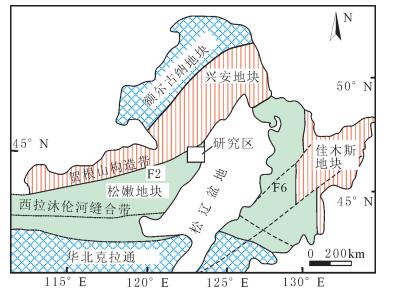
 下载:
下载:
